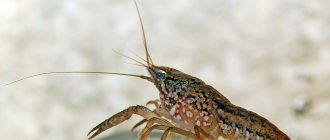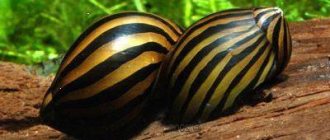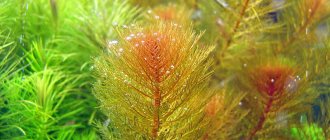We have selected for you detailed information on aquarium catfish: their appearance and characteristics of behavior, maintenance and reproduction.
| Full name | Soma/Silurus |
| Kinds | Otocinclus, ancistrus, albino, star ancistrus, pterygoplichthus, hypancistrus, loricaria, elegant, speckled, black-bellied pinnate, multispot pinnate, angel, synodontis, platidoras striped, agamixis star or white-spotted, tarakatum, corydoras, flathead or farctocephalus, red-tailed |
| Color | Black, white, silver, brown, beige, often with spots and stripes |
| Water | PH (acid-base balance) – 5-7 KH (hardness) – 6-12° t (temperature) – 22-28 °C |
| Feed | Dry: Tetra Wafer Mix, Sera Wels Chips, Sera Vipachips Nature, Zoomir Granules for bottom fish and amphibians; live food is not recommended due to the possibility of helminth infection |
| Compatibility | Guppies, gouramis, danios, barbs, angelfish, swordtails |
| Lifespan | Average 8 years |
Description
In suitable conditions it grows up to 100 cm. Lungbreathing. The gills absorb oxygen dissolved in water, and the epibranchial semblance of the lungs absorbs atmospheric oxygen. It survives in unfavorable conditions, but in critical cases it crawls to another body of water.
The skin is covered with mucus, which protects it from scratches on land. The mucus causes a painful or allergic reaction in humans.
Cases of “transitions” of 4–5 kilometers have been recorded. For this he received the nickname “walking catfish”.
Appearance
The torso is elongated, eel-shaped. The dorsal fin runs along the torso and caudal peduncle, is needed for vertical stabilization and defense against other predators, and includes 60–75 feathers with poisonous secretions. The anal fin is also extended, oblong, with 40–60 feathers. And also the poisonous pectoral fins with powerful spines upon contact cause an unpleasant wound to a person, comparable to a wasp sting.
The propulsion caudal fin is small in size. Features: lush tentacle mustaches. Four on the upper and lower lip. Used to lure food and navigate in opaque water. The eyes are round and small, but do not suffer from color blindness. Huge mouth.
The skin is thick, smooth, devoid of scales, usually brown with a gray tint. Biologists have developed aquarium hybrids with a spotted color. From time to time, red-eyed albino individuals are encountered.
The hunting method is drawing water with nutritious contents into the mouth or attacking the victim from an ambush.
Clarid catfish in an aquarium grows to 0.2–0.6 m.
Inexperienced aquarists confuse it with the sacbranch catfish. The difference is in the length of the fin: in the sacbranchial it is much shorter.
Behavior
Constantly hungry and with a difficult temperament. It comes into violent conflict with other species. It is better to keep it separately. If this is not possible, neighbors are selected based on their comparable size and aggressiveness.
Forms a stable pair with the selected female. Two pairs cannot be placed in the same aquarium, as they will fight.
Spends the day in hiding. Active at night. Loosens the soil: equipment and plants suffer.
Lifespan
Depending on the species, they live 8–20 years.
Reasons for popularity
Aquarium catfish are almost invisible in a home aquarium because they are always on the bottom. Their popularity is due to many factors:
- Huge species diversity. It is impossible to find two identical catfish. Scientists count more than one and a half thousand representatives of different species. They differ not only in appearance, but also in habits, food preferences, shape and size. Among the existing specimens, it will not be difficult to find a new resident for your home aquarium.
The reason for the popularity of catfish is the huge variety of species - High level of endurance and unpretentiousness. If a person has not previously kept fish, then the best option for him would be to purchase catfish. But do not forget about aquarium hygiene, since catfish also need clean water, regular feeding and quality care. But they are more tolerant, so they can forgive some mistakes in the content.
- Catfish are excellent at cleaning the aquarium of everything unnecessary. Since they swim on the bottom, they eat food that was originally intended for other fish. Catfish also eat algae, preventing them from growing too much in the aquarium.
This type of fish is perfect not only for beginners, but also for experienced aquarists. Catfish will be an excellent addition to other fish species.
Kinds
The genus Clarii includes 61 species. Clarias species differ in size and color. Hunting methods and habits are the same.
Clarias of the Nile
It is also marbled (African, Clarias gariepinus) common in Africa, Asia Minor and South Asia. In nature, they reach a length of 1.7 m and a weight of 60 kg. The main color takes on the color of the water. With black spots.
Produces and receives electrical signals that warn relatives when hunting “boundaries” are violated. Tolerates brackish water. Lives up to 8–10 years. In Europe and Russia it is bred in nurseries. Marbled catfish in an aquarium grow up to 1 m.
Clarias Angolan
And also the spotted clarius (karmut, sharmut, Clarias angolensis) migrated from Africa to South Asia. Under natural conditions, up to 0.5 m. In captivity, up to 0.35 m. The abdomen and main tone are white or cream. With purple, brown or black spots.
Clarias frog
Or commercial catfish (Clarias batrachus). Distributed in the South Asian region, although it has African roots. The size and weight (1–1.3 kg) are similar to the Angolan. Light belly, olive sides and black back.
Price
The variety of species of aquarium catfish gives rise to a variety of prices. Most varieties have long been bred in semi-industrial conditions. Aquarium fish reproduction workshops, filled with hundreds of aquariums, supply millions of fry to stores. Therefore, the price of aquarium catfish is reasonable.
Catfish from the Corydoras family begin their price journey at 50 rubles. Synodontis are valued at more than 100 rubles. And such a beautiful fish as the red-tailed catfish is cheaper than 200 rubles. difficult to find. That is, you can choose a fish that suits the owner with its appearance and price.
Content
The recommendations are the same for all types.
Aquarium
For young members of the family, a container of 0.1 cubic meters is suitable. A specimen that has matured and grown to half a meter will need a two-hundred or three-hundred-liter container. Grows quickly.
A secured lid is required. Otherwise he will jump out and hide.
Water parameters
Catfish is thermophilic. A water temperature of +26 °C is considered satisfactory.
The chemical composition of water is not important for keeping catfish. But if you plan to breed clarius, you need to bring the indicators to the following values: pH 6–8, hardness - up to 8°.
At least once a week, at least a third of the water is replaced with pre-prepared water.
Plants
The roots must be strong, otherwise the catfish will dig up the plant. Rough leaves are necessary, otherwise it will nibble. Grow in securely secured pots.
There are such individuals that nothing helps. In this case, you will have to say goodbye to the planted greenery.
Suitable plants are those that float in the water column and are inedible due to their strength.
Priming
Large pebbles will save you from problems with the digger. Sand should not be used. The catfish will make a lot of haze. Cleaning devices will not help: their performance is insufficient and they will quickly clog. If the noise of moving pebbles annoys you, there is no need for soil.
Decorative design
Clarias catfish loves resting shelters. Use pre-prepared driftwood. A grotto and massive stones will do. A playful pet will try to move and dig up objects.
Equipment
Clarias is a lungfish and demersal fish. Therefore, you need access to the surface and a clean, oxygenated environment. Aeration and filtration are necessary. The violent nature of the inhabitants will make it difficult to use the internal filter.
A siphon for collecting waste is required.
Lighting
Shouldn't be too bright and is intended more for plants. The standard one is also suitable (0.5 W per 1 liter of water).
Transportation methods
When buying catfish, a person thinks about quality transportation. It needs to be done correctly, otherwise there is a risk that the fish will not survive the trip home. There are two main methods of transportation:
It is best to transport catfish in a jar
Reproduction
Breeding Clarius requires large containers.
Sex differences
It is possible to distinguish the sexes after maturation at 2–3.5 years, depending on the species. Males are broad-browed and brightly colored. In females, the abdomen protrudes slightly.
Getting offspring
First, the wayward adult Clarias catfish chooses a female to mate with. To do this, several individuals are grown in a common aquarium with a water volume of 70–100 liters per individual. Future parents stay close and often touch their whiskers, and aggression increases.
The couple is isolated in a pre-prepared container with seaweed and a grotto.
After the end of spawning, the female lays eggs. If there is no grotto, then the Clarias dig a hole in the ground or find another suitable place. Until the larvae hatch, the clutch is guarded by the male.
After a couple of days, the offspring appear. After a week, they begin to swim and feed themselves. Parents are removed due to the threat of eating the young.
Overeating threatens Clarias fry with death. For this reason, the fry are fed 4–5 times a day.
They are fed with special compounds, chopped and then whole live food. They grow intensively. Larger juveniles are placed separately.
Nuances you need to know
It would seem that the given characteristics are quite sufficient to unambiguously establish the sex of a particular individual. In reality, these differences are quite difficult to notice, especially for inexperienced aquarists. The situation is further complicated by the fact that Danios are very mobile fish, so examining them is very problematic. In addition, certain nuances should be taken into account:
- the fish must not only be sexually mature, but also approximately the same in age (for example, a two-month-old “girl” cannot be distinguished from an adult “boy”);
- It is important to ensure regular and balanced feeding, as otherwise all individuals become emaciated, pale and lethargic.
Beginners are recommended to purchase several Danios so that they immediately form a school, and it is better to buy adult fish. If you plan to breed them, it is important to initially understand the sexual composition of the flock.
Diseases
- Skin damage from fights and hooligan behavior causes mycoses. They appear as light threads at the affected areas. Self-treatment can lead to the death of fish. The help of an ichthyopathologist is needed.
- Ulcers. And also from scratches. A solution of potassium permanganate helps. 0.2 g of crystalline substance per 10 liters of water in an aquarium with a complete replacement within 10–12 hours. It is more effective to place 0.5 g of the drug per 10 liters of soft water (up to 4 °C) in the prepared solution for 15–20 minutes.
- Ichthyophthyriosis. Caused by ciliates brought in from outside. They are bred by adding potassium permanganate and copper sulfate to the aquarium. If it doesn’t help, use Bicillin 5.
- Keeping it in a cramped container or without aeration risks nitrate poisoning. Expressed by lack of activity, spots on the fins, ulcers.
Natural habitat
In nature, Corydoras inhabit the water bodies of the South American continent, or rather the Parana, La Plata and Amazon basins. They are common in Uruguay, Paraguay, Brazil and Argentina.
In the wild, speckled catfish prefer clear, slow or still waters. They stay in shallow water, mainly along the banks of rivers, densely overgrown with algae, in streams and swamps. Most of the time the fish are at the bottom in search of food.
Leonard Jenyns is the naturalist who first described this species.
The first description of the speckled catfish dates back to 1842. It was made by the famous naturalist Leonard Jenyns while traveling in South America. These unpretentious, modest fish appeared in aquariums already in 1893, and a little later they were presented to the general public and won great success.
Today, almost all commercially available fish of this species are artificially bred and not taken from their natural habitat. They are perfectly adapted to life in an aquarium. Caring for the speckled catfish is quite simple, and this type of aquarium fish can be safely recommended even to a beginner.
Reviews
Claims:
- It is impossible to feed enough.
- The amount of food does not matter; it will snack on its aquarium mates.
- He arranges the premises himself. It makes noise at night.
- Doesn't get along well with plants. He even eats shellfish with the shell.
- Jumps out of the aquarium.
What they value:
- Individual character. There are non-aggressive individuals suitable for a community aquarium.
- When kept separately, it becomes attached to the owner. He will find out. Allows you to pet it. Playing. Tries not to hurt. He is wary of strangers.
- Omnivorous. Does not require separate food.
Compatibility and Behavior
Catfish are peace-loving, calm creatures, indifferent to neighbors of other species, but can start fights among themselves. It happens that a larger male chases a smaller one and tortures him to death, but such behavior is rare.
Compatibility with other species is determined by the species of the catfish. If the pet is quiet and a herbivore, then peaceful, non-aggressive fish are added to it. And for the proximity to the predator, they select large fish that do not show aggression, but do not allow themselves to be offended.
Photo
Briefly about the main thing
- Pronounced sexual characteristics in dogs appear starting from 4 weeks of life, so it may be difficult to examine newborn puppies.
- In males, the penis is first represented by a small tubercle below the navel; the belly of females is smooth and even.
- Males are larger and prone to territorial instinct. Females more often have a calm and docile character; regular estrus begins from 6-9 months. Behavior is not a primary gender characteristic.
Can you determine the gender of a puppy? Share useful tips in the comments on how to find out who was born - a boy or a girl.
Catfish: how to distinguish a male from a female
To successfully breed aquarium catfish, it is necessary to distinguish females from males. There are a number of criteria that allow you to correctly perform this task, but each species has its own differences between male and female:
Of course, in this case the list of criteria is incomplete. A number of sexual differences are strictly specific for each type of aquarium catfish. It is better to clarify these features with specialists - ichthyologists or sales consultants when purchasing catfish.
Feeding
As a large species, cockroaches require a large amount of food and a varied diet.
These fish are able to eat both dry and live food.
- Dry granulated food. It comes in the form of flakes, granules, and tablets. It includes the necessary supplements and vitamins. Granulated food is divided into fry and adult fish, for sick fish, to improve coloration, fortified and others.
- Live food. Catfish eat bloodworms, coretra, crushed earthworms, brine shrimp, krill, and pieces of meat (for example, shrimp).
- Forbs. Some catfish like vegetarian food. They are sometimes given dandelion leaves and lettuce.
Tarakatums eat a lot and have a good appetite. Sometimes they take food from other less active fish. Feed the catfish 2-3 times a day, preferably in the dark, and then the catfish will always be fed and active.
Nutrition
Feeding catfish is even simpler than keeping them. If your pets live in a tank with other fish, then you don’t have to feed the catfish at all - they will happily pick up leftover food from their neighbors, at the same time cleaning the area. When keeping only catfish fish, you can offer your wards the following products:
- Live and frozen food: bloodworms, tubifex, cyclops, shrimp, etc.
- Catfish tablets and flakes.
- Plant foods: cucumber, spinach, green peas, broccoli, etc.
Before serving, live food must be thoroughly washed, and plant food must be scalded with boiling water. If a predatory catfish lives in the tank, you should remember that small neighbors can become its lunch.
Interesting fact: hungry and predatory catfish living in their natural environment can drag even a dog to the bottom.
What does catfish eat?
Photo: Catfish underwater
The diet of catfish is very diverse, it includes:
- fish;
- freshwater;
- birds;
- shellfish;
- insects;
- fry;
- larvae;
- worms;
- vegetation.
They often eat carrion, which is why there is a common misconception that they are limited to it - it is due to the fact that this large fish looks slow and clumsy. But she is more dexterous than she might seem and, although carrion actually makes up a significant part of the menu, catfish are not averse to eating live animals.
So, they hunt a wide variety of fish - they can swim straight into schools of small fish and, opening their mouths wide, eat dozens of them at once, or they can hunt large ones, like bream or pike perch. They can also dine on large amphibians such as frogs, newts or waterfowl - although they are rarely caught.
They can catch and eat pets caught in the water - cats or small dogs. There are even cases of attacks on calves caught in the water and, moreover, on people. It is difficult to say whether catfish are actually dangerous for humans; we only know for sure about people who were bitten by them and who accidentally stepped on their nest.
Young catfish feed mainly on the fry of other fish, aquatic insects, small crustaceans and larvae. As adults, they can also eat all of the above, but they do not specifically hunt for them - they simply open their mouths and suck all these small animals into it.
They hunt mainly at night, and can either search for prey at the very bottom or rise to the surface where they can find small fish. They remember where the old net was left and constantly check it to see if the fish are entangled there.
For the most part, they feed on fish, and during the hunt they can hide - usually the color of their skin blends with the river bottom, so the prey may not notice the hunter for a long time, until it ends up almost in his very mouth. If she managed to escape, the catfish does not pursue her for a long time.
They are distinguished by their gluttony: even taking into account their size, they eat a lot, especially in the spring, after nature comes to life and there is more prey - during the winter they manage to get pretty hungry. Here everything is eaten, even aquatic vegetation, although catfish usually prefer animal food.
Interesting fact: Whiskers are very important for catfish; they are used by the catfish to search for prey - even in complete darkness, with their help the catfish senses its approach. In addition, they can act as bait - hiding, he exposes them and lures small fish, which take them for prey.
Adviсe
Tarakatum catfish are loved by aquarists because of their vitality and endurance, omnivorousness and interesting behavior. They will continue to inhabit aquariums with various inhabitants for a long time.
Previous
Varieties of Cherry barb (veil): maintenance, breeding (reproduction), compatibility, photo, care, description
Next
Varieties of catfish synodontis (changeling): compatibility with other aquarium fish, maintenance, types, reproduction, photos
Great article 0
Relationships with people
Pseudoplatistoma is prized for its succulent, boneless meat and is in high demand locally and exported throughout South America. Fans of sport fishing love the speed and power of these fish; on the Internet you can see a large number of photographs of anglers with their trophies.
It is possible that uncontrolled commercial and sport fishing has led to the extinction of Pseudoplatystoma in some tributaries of the Amazon, Orinoco and Magdalena. Indeed, in the Argentine province of Entre Rios alone, about 27,000 tons of Pseudoplatystoma spp are caught annually. Since spawning of this fish can be initiated by hormones, there is great potential for commercial production as food and seed material, including for the aquarium business. P. fasciatum and P. tigrinum are common in public aquariums.











